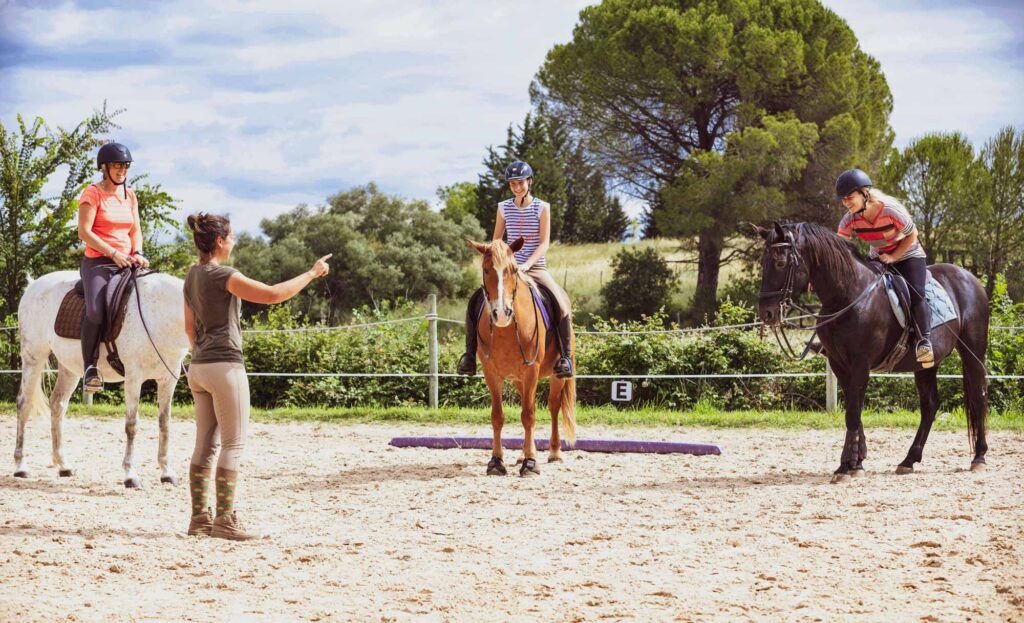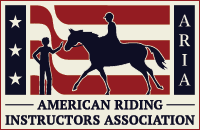
Instructor Certification
Take the next step in your career by becoming an ARIA certified instructor. Already a certified instructor? ARIA is now renewing certifications for 2026. Renew early and save!
Specialities: The Areas of Certification
ARIA Certification is available in 16 teaching specialties. Instructors may be certified in one or more of these specialities.
Distance Riding: Endurance & Competitive
Level I
Knowledge of training, horsemanship, safety and good conditioning practices; also pleasure trail riding and organized group trail rides. Must have ridden a minimum of 50 competitive miles
Level II
Same as above. Must have ridden a minimum of 200 competitive miles.
Level III
Same through open competitive trail division - 50 mile endurance rides. ECTRA and AERC rules. Must have ridden a minimum of 500 competitive miles.
Dressage
Level I and II
Concepts, exercises and movements through 1st level. Must know USEF rules.
Level III
Concepts, exercises and movements through 3rd level. Video must show work at 2nd or 3rd level.
Driving
Level I and II
Knowledge of Pleasure Driving, correct and safe harnessing procedures, and training of horse and whip.
Level III
Ability to coach for Competitive Driving.
Eventing
Level I and II
Knowledge of concepts & exercises of Dressage, Cross Country & Stadium Jumping through USEA novice level. Video for Level II must show ability to coach cross country work and relate flat work to jumping. We must see some work outside of a ring to pass an instructor as capable of teaching eventing.
Level III
Same as above, through USEA training and preliminary level Horse Trials (one day events). Video must show cross country lesson, and must address conditioning and preparation for this level.
Eventing videos must show work in all 3 phases, including work outside of the arena.
Hunt Seat
Level I and II
Knowledge of equitation and exercises in flat work and jumping through 3’ (Equivalent to USEF Limit Equitation), USEF rules for Equitation and Hunters. Counting strides, finding spots, simple changes, correct change over jumps, shortening & lengthening, etc.
Level III
Must show lesson relating flat work to jumping, suitable for riders who are capable of jumping 3’-3’6”. (Note: It is not required that riders actually jump 3’ to 3’6” in this lesson)
Hunt Seat on the Flat
All Levels
Knowledge of equitation and exercises in flat work only - no jumping.
Mounted Patrol Training Officer
Level I and II
Knowledge of equitation and exercises in flat work, related cavaletti exercises, basic concepts and exercises of horsemanship, safety and conditioning. Knowledge and skills in training officers in police work as well as re-schooling mounts. Department of Criminal Justice Standards (DCJS) certification as General Police Instructor recommended but not required.
Level III
Knowledge of equitation and exercises in flat work and related exercises, knowledge and skills in reschooling and re-claiming of mounts; knowledge and skills in all related Mounted Police procedures, patrol procedures, and unit objectives. DCJS certification as General Police Instructor highly recommended. Video and lesson plan required, utilizing an ARICP approved Mounted Police topic. (List of approved topics will be sent upon request)
Recreational Riding
Level I and II
Teaches basic horsemanship to those who ride for pleasure and recreation with an emphasis on safety, a balanced seat, and a caring and responsible attitude toward the horse. May be English, Western or both. Includes instruction of beginners, the first-time horse owner, recreational pleasure and trail riding, and/or public or resort riding programs. (While instructors may teach students of different capabilities, the Recreational Riding Rating is not to be construed as a rating in Therapeutic Riding.) Safe trail riding and basic first aid procedures are emphasized.
Level III
Instructors who teach Recreational Riding beyond Level II are encouraged to seek Level II or higher certification in Hunt, Western, Saddle Seat or one of the other ARIA specialties. However, an instructor who teaches a program which exceeds Level II standards in Recreational Riding, but does not fall into any of the other recognized specialty areas, may apply for a Level III rating in Recreational Riding. The candidate must be prepared to show that the standard of his/her teaching and program are the equivalent of Level III requirements for other specialties.
Reining
Level I and II
Must be able to instruct beginning to intermediate reining competitors
Level III
Must be capable of instructing at all levels of reining and training horses as well as coaching for the USEF Reining Seat Medal, and should have some knowledge of other events which include reining.
Riding to Hounds
Pre-requisite to the taking of these tests, candidates must provide the ARIA office with proof that they are currently (and have been for a minimum of three years) a member of, or subscriber to, a hunt recognised by, or registered with, the MFHA, and must have been awarded their colors. A letter from the hunt’s Honorary Secretary or MFH will be considered proof. In the case of a candidate who is no longer a riding member of a hunt, a letter from the same source indicating previous participation and awarding of colors will be considered.
Level I and II
Must demonstrate the ability to prepare riders for riding as members of the “flat” or hill-toppers field, able to ride safely over natural terrain, to control their horses in a large group and around hounds, and to be aware of the courtesies and correct behavior expected of a member of the field.
Level III
Must be able to prepare riders to take part as members of the field in a more active way, able to think for themselves in an emergency; to prepare them as safe members of the jumping field; and to impart a degree of understanding of actual hunting and “woodcraft.” It is in no way expected, nor implied, that ARIA Riding to Hounds certified instructors should be able to train hunt staff.
Show Jumping
Level I and II
Knowledge of flat and fence work, and USEF Jumper rules through ALL LEVELS. Teach through schooling jumpers (3’6”). Video for Level II must show jumping lesson relevant to this level.
Level III
Same through USEF preliminary and intermediate. (4’6”). Video must show jumping lesson relevant to this level.
Saddle Seat
Level I and II
Teaching and training basics through USEF Limit Equitation and saddle seat pleasure classes. Know USEF Equitation rules. Knowledge of various breed rules helpful.
Level III
Same as above, also including Open Equitation and Park or 3 gaited (or breed) classes.
Side-Saddle
Level I and II
Introduction to side-saddle. Proper position at all gaits, training of horse to side-saddle, correct fitting of tack and equipment, correct turnout of horse and rider for both formal and informal showing
Level III
Competitive side-saddle riding, USEF rules, basic work over fences (to 2’6”). Knowledge of various styles of riding side-saddle (i.e. hunt seat, western, dressage, saddle seat) and correct equitation and dress for each.
Stable Management
An ARIA certification in Stable Management indicates that the holder of the certificate is certified in Stable Management. The holder of the Stable Management certificate may or may not also instruct others in Stable Management. Stable Management certification, just as all the specialties, may be earned at any one of the three levels.
Level I
Level II
Level III
Stable Management Video
Applicant must provide a video of 20-40 minutes duration, giving the evaluators a “walk-through” of the barn for which the candidate is responsible and for which the candidate him/herself has done all the work which is seen in the video. The following should be included in the video:
A listing /showing of posted barn rules, warning and other signage. Emergency numbers and evacuation route.
An explanation of how the stalls are prepared and how the barn is kept clean and organized.
A demonstration displaying recognition and prevention of common ailments treated by a stable manager, such as thrush, saddle sores, and at least two others.
A discussion of basic daily routines for grooming, feeding, watering and turn out of horses at the facility.
A recognition of good and bad conformation in horses.
An explanation of the use and purpose of common grooming implements.
An explanation of stable dangers, such as barn fires, and what is done to prevent them.
A description of how to recognize good and bad hay and feed. Describe/show storage of grain and hay.
A discussion of various stable bedding methods and the benefits/drawbacks of each.
A discussion of blanketing, summer sheets and other coverings used at your facility – when and why they are used.
A discussion and demonstration of bandaging for travel and for at least two other purposes.
A discussion of shots, worming, and keeping records.
One other subject, of the candidate’s choosing, which he/she feels is an important aspect of stable management.
Western Dressage
Level I and II
Knowledge of the USEF rule book for the Western Dressage Division and understanding of the goals of Western Dressage. Ability to teach riders and horses, regardless of their background, through the First Level. The video for Level II should demonstrate work on the elements of the First Level tests and should include a brief discussion of both the saddle and bridle/bit used and how they influence the horse and the rider in your lesson.
Level III
In addition to the requirements of Levels I and II, must show understanding of the progressive training of the horse towards higher degrees of collection, and ability to instruct the riders at the Second Level and above. The video for Level III must include some lateral work (at a gait appropriate for the horse’s level of training; for example, if the horse is just starting to learn half pass, showing the work at the walk is sufficient).
Western Equitation/Pleasure
Level I and II
Knowledge of Western equitation and Western pleasure, including USEF and/ or AQHA rules for these events.
Level III
Must show lesson suitable for riders who are capable of competing in Western horsemanship, and/or other performance events. (Lesson need not relate to competition, but must be taught to riders at this level.)
Stand Out With Our Nationally Recognized and Respected Certification
The ARIA Instructor Certification Program uses a carefully designed and thought-out system of checks and balances to determine the earning of certification. Our Evaluation Board assess all aspects of each candidate's demonstrated knowledge of the discipline they wish to teach, as well as their attention to professionalism, safety, and business and personal integrity.
All levels of ARIA certification are hard-earned and well respected. Major insurance companies recognize ARIA Certification, and offer those instructors a substantial discount on their equine-related insurance needs.
Earn Your Certification From Anywhere with Online Testing
In an effort to accommodate travel and gathering limitations due to the pandemic, as well as your busy schedules, The American Riding Instructors Association now offers online testing! Technology and state of the art testing software means our online testing upholds the same standards follows the same protocols as our in-person testing has for over 41 years, only now you can test on a day that works for you, from the comfort of your home.
A limited number of in-person test centers will remain available for those who prefer a more traditional Instructor Certification testing experience. All upcoming test center dates are listed on the testing registration page.
